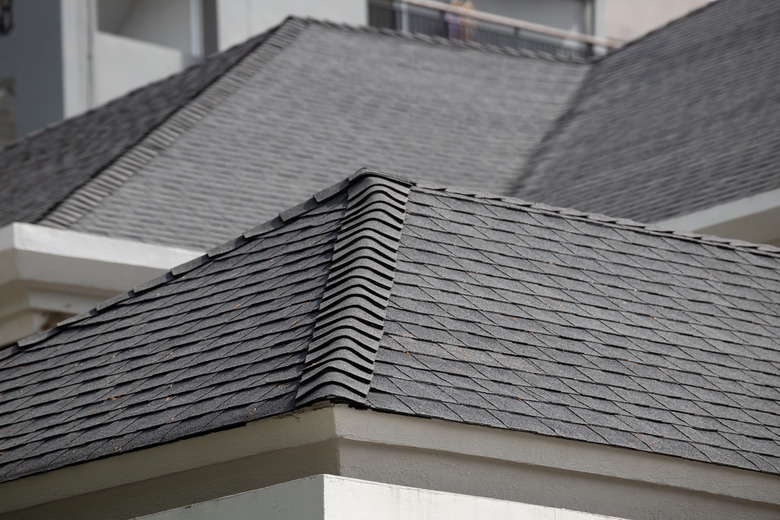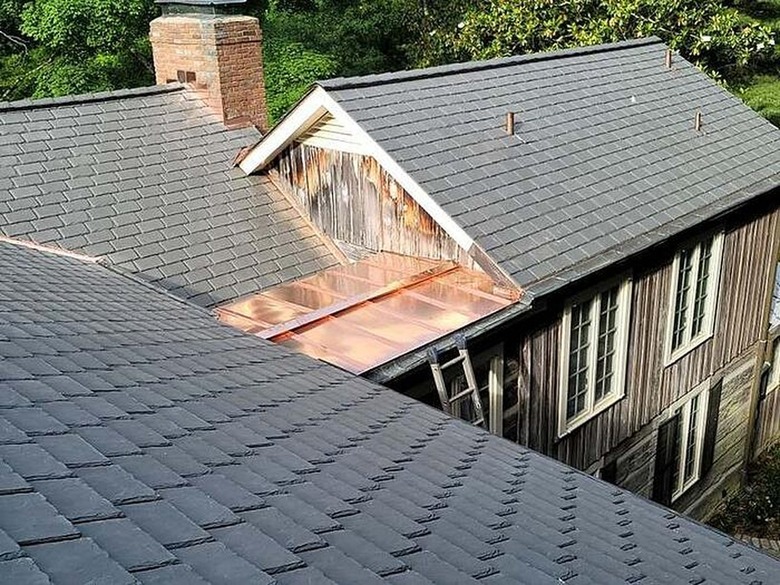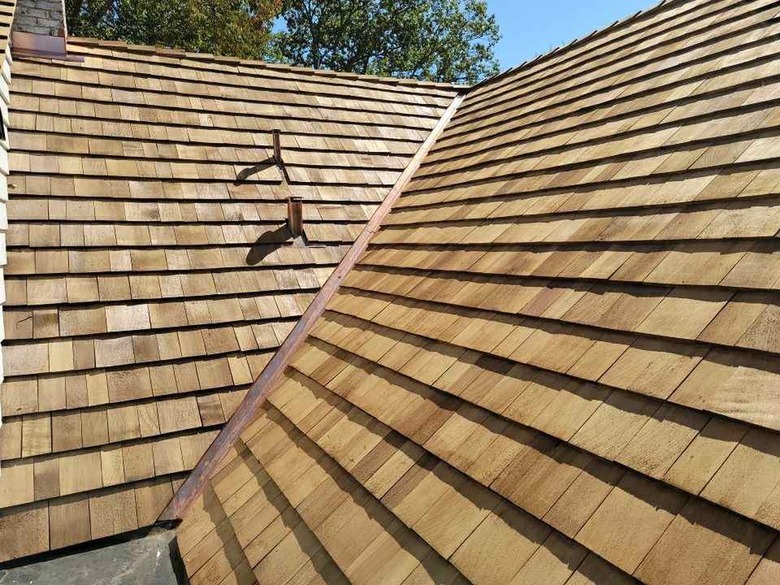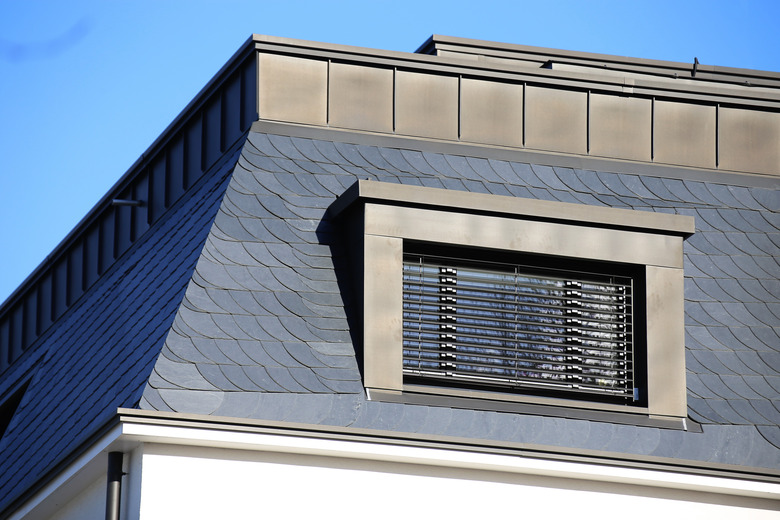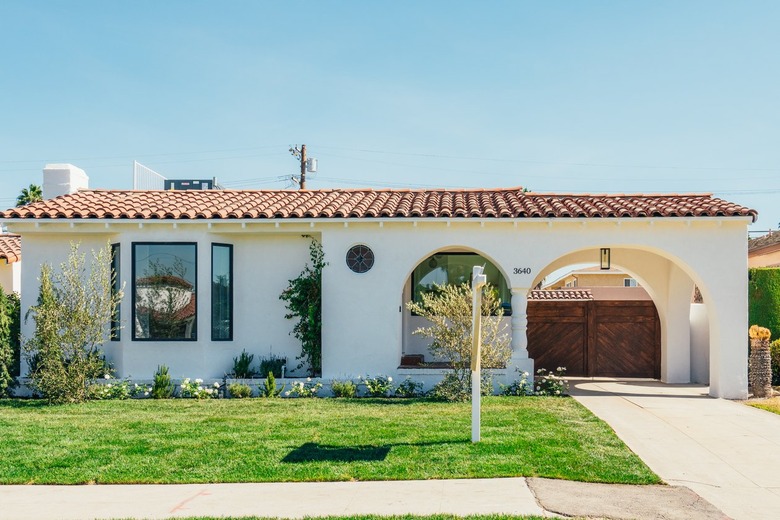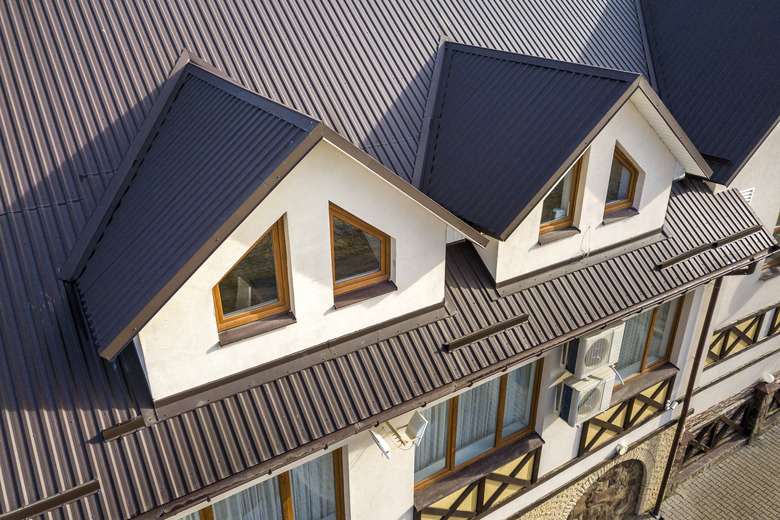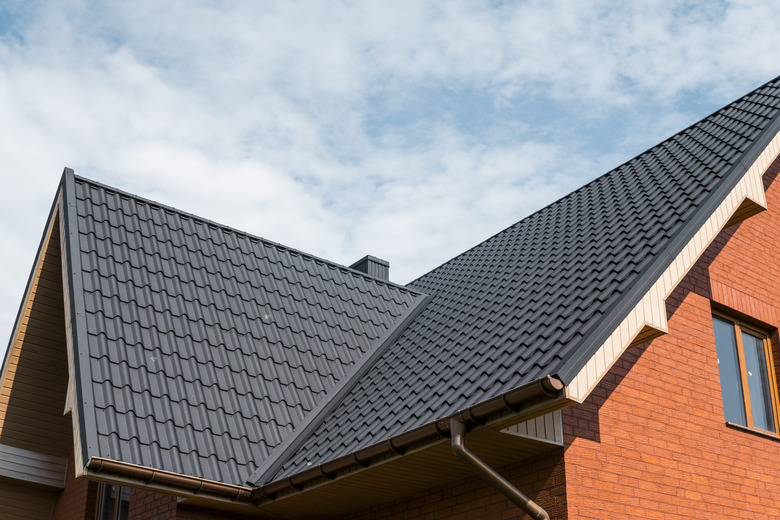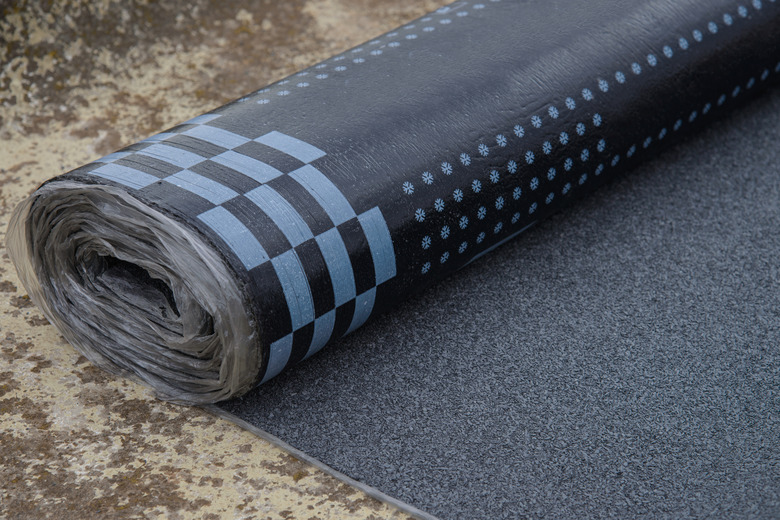Roof Types 101: A Complete Buyer's Guide For Homeowners
We may receive a commission on purchases made from links.
Replacing a roof is a serious home improvement and a major investment. In fact, replacing your old roof will cost around $8,561 on average including materials and labor costs (and the average price range varies from $5,589 to $11,671).
A homeowner's choice of roofing materials plays a dramatic role in the overall roof replacement cost as well as its appearance and life span. Similarly, while you can save some money on installation costs by going the DIY route, this is not an option for many materials, particularly slate, which requires not just any roofing company but a roofer who is experienced with this heavy material that is difficult to work with.
Getting ready to replace a roof and not sure what material or type of look you want? Here's a comprehensive guide to the most common roof types — and how much you'll spend on each one.
How to Estimate Your Roof Cost
How to Estimate Your Roof Cost
When calculating your overall roof cost, keep in mind that these materials are usually sold and priced by the square, which is a 100-square-foot space. To determine how much the materials for your roof installation will cost, you'll need to multiply the number of squares you will need by the overall material cost.
To determine the square footage of your roof, calculate the area of each section of your roof by multiplying the length and width. Add together the total area of all sections to find the total roof size and add in an additional 10 percent of materials to account for waste. Then, divide this number by 100 to find out how many squares you need.
Tip
Always round up the total number of squares to ensure you have enough materials.) Keep in mind that it's always good to have some extra materials left over so you can be covered for future repairs if the manufacturer discontinues your roofing product.
As an example, imagine a homeowner has only two roof sections, each measuring 55 x 30 feet. The total roof size would be 3,300 square feet. They should order at least 3,630 square feet of materials, which amounts to 37 squares.
Asphalt Roofing Shingles
Asphalt Roofing Shingles
Asphalt roofing shingles (also known as composition shingles) are the most popular type of roofing in America and are made from fiberglass or cellulose mats, which provide strength to the shingles. Asphalt roofing shingles are also saturated in asphalt that makes the roof waterproof. The top of the shingles are then coated in ceramic, which provides color to the shingles and provides UV resistance. Over time, these ceramic granules fall off due to normal wear and tear.
There are three categories of asphalt shingles: three-tab shingles, architectural shingles, and multilayered architectural shingles. Three-tab shingles are the least expensive and the thinnest but are the only type of shingle that can be installed over a single layer of existing roof shingles. Architectural shingles are thicker and are a bit more luxurious and architecturally interesting. Multilayered architectural shingles cost even more, but they are the thickest and sturdiest and can mimic the look of other types of high-end shingles like wood shakes.
Pros: Asphalt shingles are moderately lightweight, inexpensive, recyclable, low maintenance, and relatively easy to install. Repairs are typically simple. Shingles are available in many color options, including green, black, brown, red, and blue.
Cons: These shingles aren't the most attractive and are generally considered a standard or utilitarian roofing material. Additionally, the loss of granules over time detracts from the overall appearance and durability.
Best uses: A variety of colors and thicknesses mean they look good on most homes. They can be used on low or steep roofs.
Performance: They hold up well in many weather conditions, including rain, ice, and snow, but they can tear off in high winds. Lower-quality shingles offer poor impact and wind resistance.
Life span: An asphalt shingle roof will typically last 15 to 30 years, but in warm, humid climates, this number can drop to 10 years. Manufacturer warranties for three-tab shingles are typically 20 to 30 years, whereas architectural shingles can have a lifetime warranty with prorated payouts after 20 years.
Price: $75 to $150 per square, with three-tab shingles on the low end and multilayered architectural shingles on the high end.
Synthetic Roofing Shingles and Tiles
Synthetic Roofing Shingles and Tiles
Synthetic (composite) shingles and tiles are made from materials such as rubber, plastic, and polymers that imitate the appearance of natural materials, such as slate, clay, and wood. While they may be cheaper than natural slate, they are reasonably pricey, but they allow you to avoid many of the drawbacks of these natural materials since they are easier to install and will not require additional framing, like many heavy tiles.
Pros: These synthetic products are strong, low maintenance, lightweight, impervious to insect damage, recyclable, resistant to rot, made from recycled materials, and offer good imitations of other roofing materials. Their installation does not require roofers with a specific specialty.
Cons: Unfortunately, they may not last as long as real slate or clay tiles and cost more than concrete tiles or wood shake.
Best uses: Because they can mimic so many different styles of roofs, they look good on just about any home.
Performance: Very durable, these tiles do well in heavy winds, rain, snow, and ice, and they have high ratings for impact damage and fire resistance.
Life span: Expect these tiles to last around 35 to 50 years, but before shopping, find older examples of the material in your area to see how they look after being worn from the elements. Only purchase composites with a warranty over 50 years.
Price: Prices vary based on quality and appearance but range from $400 to $1,200 per square.
Wood Shingles and Shakes
Wood Shingles and Shakes
These natural roofing materials, usually made from cedar, red wood, and pine, weather to a soft gray shade, giving homes a traditional, rustic appearance. Wood shingles are typically cut by machine and look more evenly sized and smoother than wood shakes, which are hand-split and look rougher.
Pros: Wood shingles and shakes are both biodegradable, provide good insulation, and can be moderately priced.
Cons: Unfortunately, they are prone to termites, cannot be installed by DIYers, and require more maintenance than other roofing materials.
Best uses: The rustic appearance of wooden roofs looks good with vintage-styled homes, such as cottage, Craftsman, Tudor, and Cape Cod styles.
Performance: They hold up well in high winds but can split, mold, or rot in wet conditions. Wooden shingles and shakes are very flammable, are best avoided in fire-prone areas, and are prohibited by many local building codes. If they are permitted in your area, look for Class A wood roofing materials that feature a fire-resistant coating.
Life span: A typical life span is between 15 and 30 years, but wood shakes can last up to 40 years in the right conditions. Warranties vary greatly in this industry, but expect to see a limited warranty that last between 25 years and a lifetime.
Price: The materials for a wood roof will cost about $250 to $900 per square.
Slate Roofing Tiles
Slate Roofing Tiles
While slate tiles don't match every home's aesthetic, the material is beautiful, and it is one of the most durable roofing materials available. The unique stone comes in a variety of shades, including black, green, red, gray, and even purple. Unfortunately, it is notably difficult to work with, so you can't hire just anyone to install it. You may need extra framing to support the material.
Pros: Slate is a luxury material that is recyclable, fire-resistant, incredibly durable, and particularly attractive.
Cons: Because it is so heavy, slippery, and difficult to work with, slate requires a specialized roofing contractor, and some home frames must be reinforced to support the weight. Also, the total cost of a slate roof makes it one of the most expensive options available.
Best uses: Slate is best used on steep roofs where rainwater won't pool. Slate looks best on historic homes with gothic, Colonial, Victorian, European or French chateau styling.
Performance: Slate is practically indestructible under even the most extreme weather conditions and is very fire-resistant.
Life span: It should last at least 50 years if properly installed and maintained, but these roofs can easily last over 100 years with proper care. That being said, materials do not typically come with a warranty.
Price: Prices are usually between $800 and $1,800 per square.
Clay Roofing Tiles
Clay Roofing Tiles
A popular sight in the Southwest and Florida, clay roofing tiles have a distinctive warm appearance and are almost as long-lasting as slate. They are typically found in half-barrel, flat, ribbed, and scalloped shapes and are a reddish-brown color, though they can also be found in shades such as black, brown, and green. Some tiles even mimic slate or wood shakes.
Pros: Clay tiles are durable, fire-resistant, and highly resistant to UV rays.
Cons: Installation of clay tiles is difficult and time consuming, requiring a professional experienced in these materials, and like slate, the weight may require a roof frame to be reinforced before installation.
Best uses: Well suited to Mediterranean, Mission, Southwestern, or Spanish architectural styles.
Performance: While they are very fire-resistant and do well in hot weather and heavy rains, clay tiles can crack in extreme cold weather, when they are walked on, or when they are hit with high impact.
Life span: They can last as long as 75 years, but tiles break or chip under heavy impact and may need to be replaced. Manufacturer warranties typically range from 50 years to a lifetime.
Price: The average cost is between $350 to $1,800 per square, with imported Mexican clay tiles on the low end and specialty tiles coming with a premium price tag.
Concrete Roofing Tiles
Concrete Roofing Tiles
Concrete tiles share a lot in common with clay tiles only they are less expensive and have a lot more versatility in terms of appearance since they can be colorized, shaped, and textured to look like clay tiles, slate tiles, or wood shakes.
Pros: Versatile, inexpensive, insectproof, and incredibly durable, concrete tiles are a good option for many homes.
Cons: Like other slate or clay, concrete tiles are often very heavy and require reinforced framing and roofers specialized in this specific material. However, there are some lighter concrete tiles available on the market as well.
Best uses: These tiles can work on just about any style of home.
Performance: These tiles do very well in heavy rain, hail, and wind but can crack when exposed to freezing temperatures. Concrete is naturally fireproof, making it a good option in fire-prone areas.
Life span: They should last at least 30 years but can last 50 years with proper maintenance. Many companies offer lifetime warranties, but failure to properly maintain the roof may void the warranty.
Price: The average cost is between $150 and $300 per square.
Metal Standing Seam Roofing
Metal Standing Seam Roofing
Made from metal panels with vertical seams that add rigidity and support to the structure, this type of metal roof has a distinctive appearance that can look rustic, modern, or classic depending on the metal, its patina, or its paint. A wide variety of metals can be used, including steel, zinc, aluminum, and copper.
Pros: Metal standing seam roofing is UV-reflective, good for rainwater collection, recyclable, resistant to rot, and very lightweight. As an extra bonus, some metals may develop an attractive patina as they age.
Cons: Snow guards may be required on these roofs to prevent ice sheets from sliding off of the roof and injuring people. Because the installation process is so different than other materials, a contractor experienced in metal roof installation is required.
Best uses: They look good on bungalows, cabins, cottages, and some historic or contemporary-styled homes and can be used on low to steep roofs.
Performance: They are fireproof and resistant to extreme weather conditions but can show dings from hail or objects that hit the roof in high winds. Modern textures on these products hide this damage better.
Life span: These roofs should last at least 50 years and may last over 100 years. Warranties typically last a lifetime, but the warranty on the painted finish may last only 30 years.
Price: The typical cost is anywhere from $200 to $1,000 per square depending on the specific type of metal used.
Stamped Metal Shingle Roofing
Stamped Metal Shingle Roofing
Stone-coated metal shingles are interlocking metal panels that are formed to look similar to other types of roofing, such as wooden shakes, slate, asphalt shingles, or clay tiles. These panels are typically made from aluminum, copper, or steel, which is then covered in a primer, followed by acrylic paint and then a layer of stone granules, and topped with an acrylic overglaze.
Pros: Fireproof, durable, attractive, and lightweight, metal shingles are less expensive than many of the materials they mimic. Additionally, they can be installed over existing asphalt shingles.
Cons: Metal shingles require an experienced installer to avoid denting or damaging the panels.
Best uses: They can be used on just about any style of home.
Performance: They are not suitable for low-slope roofs, which can result in water pooling. Otherwise, they perform well in all weather conditions.
Life span: They should last at least 50 years. They may only have a 30-year warranty that covers the paint finish on the materials, though some manufacturers offer lifetime warranties.
Price: The cost is usually between $800 and $1,400 per square.
Asphalt Roll Roofing
Asphalt Roll Roofing
Made from the same materials as asphalt shingles, asphalt roll roofing is sold in a 36-inch-wide x 36-feet-long roll, meaning each roll covers about one square. Because it is so inexpensive and easy to install, this material can be a good temporary option if your roof is severely damaged, but you can't get a professional to install a new roof for a while. It is more commonly used on exterior structures, like garages and sheds.
Pros: Lightweight (each roll is about 75 pounds) and easy to install, even for DIYers, asphalt roll is the cheapest roofing material available.
Cons: Unfortunately, asphalt roll is the thinnest and least durable roofing material and is notably easy to rip.
Best uses: It is best used for temporary roofing installations and exterior structures, such as sheds or garages.
Performance: Since it is not very durable, roll roofing should be checked regularly for damage to avoid leaks or damage to the interior structure.
Life span: Lasting only five to 15 years, this is not a good long-term option for homes. Limited warranties may last around 10 years depending on the manufacturer.
Price: The average cost is about $50 per square.
References
- Consumer Reports: Roofing Buying Guide
- HomeAdvisor: How Much Does A Metal Roof Cost?
- Sheffield Metals: Standing Seam vs. Stamped Metal Shingle Roofs: Which is Best For You?
- HomeAdvisor: Roofing Material Prices
- HomeAdvisor: How Much Does It Cost to Replace or Install a Roof?
- Forbes Advisor: The Ultimate Roofing Buying Guide For Homeowners

